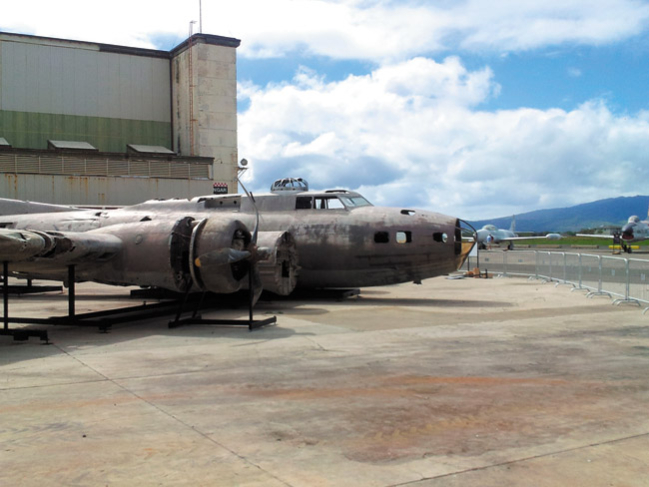The Swamp Ghost’s New Home
Pacific Aviation Museum at Pearl Harbor is a wonderful success story that just keeps going – and growing.
Occupying two Ford Island World War II aircraft hangars, the first is the current main display area with several state-of-the-art displays featuring WWII aircraft as if in flight or in natural-looking settings, aircraft carrier decks or sandbagged airfield bunkers. Also in this first hangar are offices, educational classrooms, gedunk (traditional military term for a small cafe or eatery) outfitted to jump right out of the wartime 1940s, and a sparkling gift shop featuring unique gifts such as WWII and military aviation books, models, posters, and T-shirts (some featuring Rosie the Riveter).
In the registration area is a new display area featuring a broad array of old China Clipper memorabilia recalling some of the earliest days of Hawaii’s more plush commercial air service. And covering the floor of the entry foyer is an aerial map of Pearl Harbor, Hickam, much of Halawa, Aiea and Pearl City. What fun to walk up Aiea Hights Drive and stick the toe of my slipper into the likeness of our pool.
The larger adjacent hangar is scheduled to eventually become a second display area, but for now it is occupied by a diverse array of aircraft in various stages of repair and restoration – from a sparkling F-111 aircraft (one of the first to feature “swing wing” design, i.e., variable sweep wings), acquired from the Australian Air Force.
To the opposite extreme, displayed outside the hangar is a badly corroded, derelict B-17E bomber, No. 41-2446, built by Boeing aircraft in the early 1930s. Army Air Corps contracted with Boeing to build 39 planes, the first of 12,431 ultimately purchased. The B-17 “Flying Fortress” carried most of the bombing mission load during the early part of the war in the Pacific, and ultimately the war over Nazi Germany, as well.
Like most of the aircraft in the museum, No. 41-2446 has its own unique story. After a bombing raid over Rabaul, New Briton, harassed by Japanese Zero fighters,
dodging severe thunderstorms, battle-crippled and low on fuel, this B-17 was unable to reach its alternative landing field at Port Moresby on the large island of New Guinea (much less its home base in Australia). The pilot spied what he thought was a flat, green field, but it really was the greened-over Agaiambo swamp, where he deftly settled the Flying Fortress down, as the museum narrative has it, “into 5 feet of water and thick Kunai grass.” The uninjured crew destroyed the highly secret Norden bombsight – a “tachometric” device for aiming bombs which only the U.S. used – and began what turned out to be a six-week slog through thick, mosquito-infested jungle, from which they finally emerged on the southern coast of the island near Port Moresby, “exhausted and sick with malaria.”
For the next 50-plus years, the plane sat in that swamp, becoming a familiar landmark to passing military pilots. Referred to by Aussie pilots as the “Swamp Ghost,” the name stuck and is known to countless aviators who fly the South Pacific.
In 2006, a benefactor financed the arduous salvage of the plane, which had to be cut into pieces and helicoptered out of the swamp. The pieces remained on a New Guinea dock for four years while the island government dithered about exporting the wreckage or not. There was a further delay in San Francisco until it could be returned to Hawaii, where it started out.
Today, the “Swamp Ghost” can be seen mounted on a steel armature on a Ford Island ramp between the two hangars of the Military Aviation Museum. So far, only one of the four bent-back propellors has been removed from inside the hangar and reaffixed to one engine. The wings are attached to the armature at exactly the same angle of tilt at which the “Swamp Ghost” had languished all those years in the swamp, according to the water marks inside the fuselage.
Oh, and the Norden bombsight was never found.
coffee1776@ gmail.com






